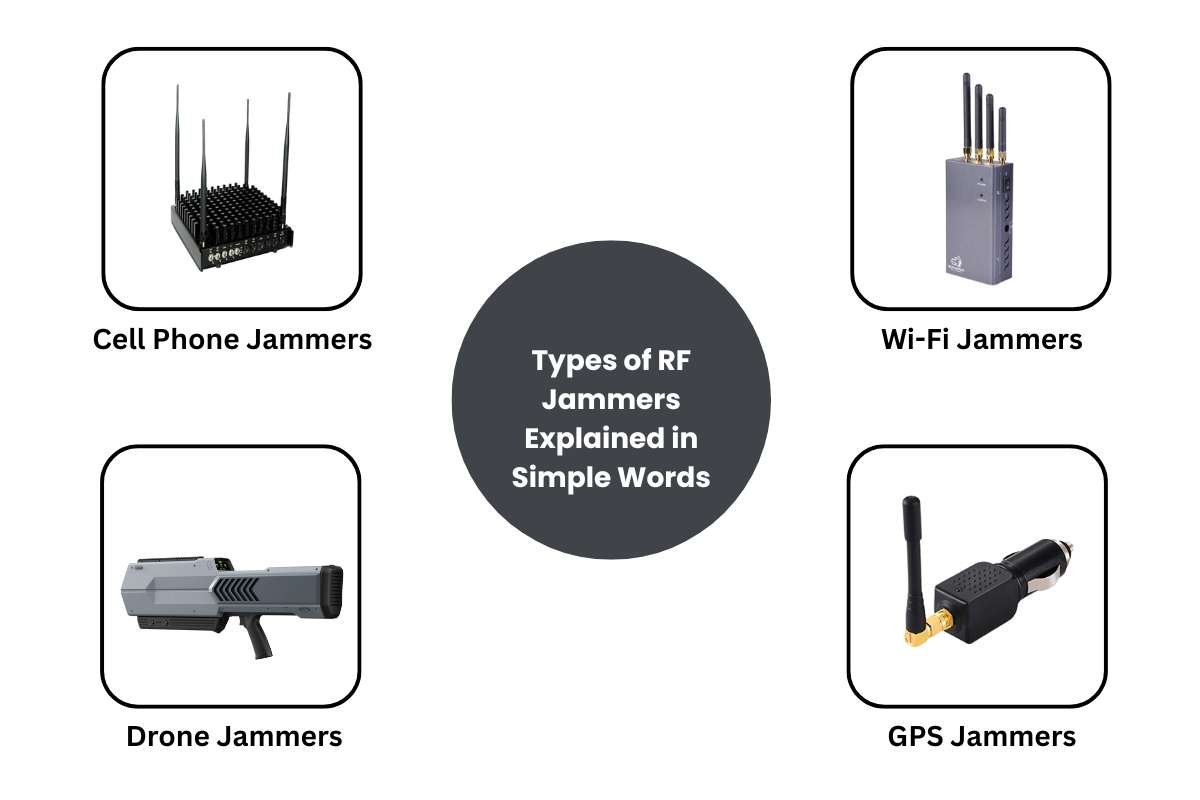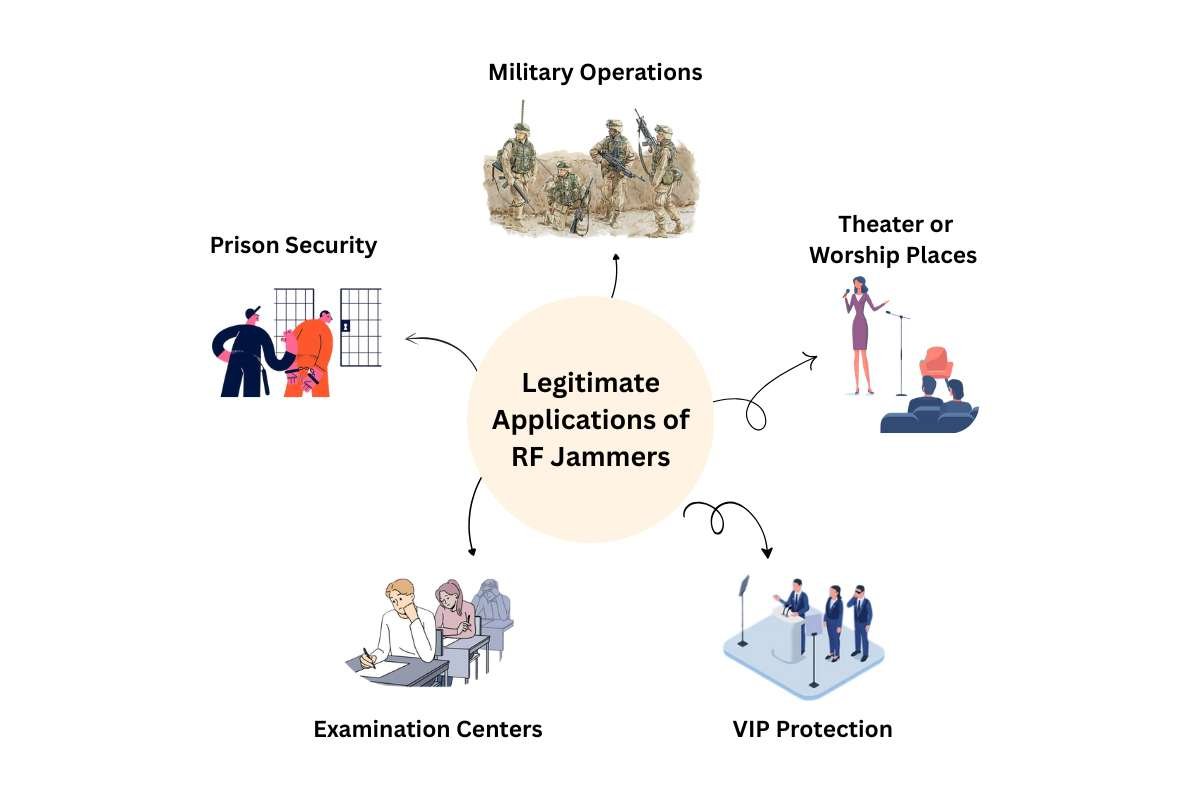Ever wish you could silence a loud cellphone in a movie theater? Or stop a drone buzzing overhead?
That’s where a Radio Frequency Jammer steps in, like giving unwanted signals a taste of their own medicine. But it is not all cool gadgets and spy stuff. Some of it’s illegal. Some of its genius. And some of it. Well, you all want to read on before pressing any buttons. Let’s break the static and tune in.
What is an RF Jammer?
A Radio Frequency Jammer is a device that blocks, disrupts, or interferes with radio frequency signals. These frequencies include anything from mobile phones to Wi-Fi networks, GPS systems, and remote controls.
By emitting radio signals at the same frequency as the target device, an RF Jammer overwhelms the communication channel, making it impossible for the intended device to work correctly. This can result in blocked phone calls, dropped drone controls, or GPS errors.
They are commonly used in military, security, and surveillance fields, but also sometimes in shady or illegal ways.
How RF Jammers Work?
An RF Jammer sends out signals on the same frequency as the target device but at a higher power. Imagine two people talking in a quiet room, and suddenly a third person starts yelling nonsense at the same volume, and they can’t hear each other anymore. That’s essentially how jamming works.
The RF Jammer usually has:
- A power source
- An antenna
- A frequency generator
- Amplifiers to boost signal strength
Once turned on, the jammer floods the frequency with interference, making devices useless within the range.
Types of RF Jammers Explained in Simple Words
RF Jammers are tools that stop radio signals from working. Here’s a simple look at each type with examples.

1. Cell Phone Jammers
What They Do:
These jammers block mobile signals like 2G, 3G, 4G, and 5G. When turned on, people nearby cannot make calls, send texts, or use mobile data.
Where they’re used:
- In prisons, to stop inmates from using illegal phones
- In exam halls, to prevent cheating through phones
- In movie theaters or meeting rooms, to avoid disruptions
Example:
Imagine you are in an exam hall and someone tries to use their phone to cheat. A cell phone jammer blocks the mobile signal, so the phone won’t work.
2. Wi-Fi Jammers
What They Do:
Wi-Fi jammers block wireless internet signals (usually 2.4 GHz or 5 GHz). They stop devices like laptops and smartphones from connecting to the internet.
Where they’re used:
- In government buildings during secret meetings
- In schools, to block the internet during tests
- In homes, to stop neighbors from stealing Wi-Fi
Example:
A company doesn’t want internet leaks during a confidential meeting. So, they use a Wi-Fi jammer to cut off all internet connections nearby.
3. GPS Jammers
What They Do:
These jammers block GPS signals that help devices know their location. They stop things like car trackers or mobile apps from knowing where you are.
Where they’re used:
- In vehicles, to avoid being tracked
- By criminals to disable tracking devices
- In military vehicles, to avoid detection
Example:
A thief steals a car with a GPS tracker in it. They use a GPS jammer so the car owner can’t track the vehicle’s location.
4. Drone Jammers
What They Do:
Drone jammers block the communication between a drone and its remote controller. This causes the drone to stop flying or return to where it came from.
Where they’re used:
- Around airports to avoid drone accidents
- In military areas to stop spying drones
- At public events for security
Example:
A drone is flying over a restricted military base. A drone jammer is used to cut off the signal, forcing the drone to land or fly back.
Similar Articles:
- Wireless Network Jammers: What They Are, How They Work, and Their Implications?
- How Augmented Communication Devices Could Enhance Connectivity?
Legal and Ethical Considerations
Using an RF Jammer may sound useful, but in most countries, it’s illegal. For example:
- United States: The Federal Communications Commission (FCC) bans the marketing, sale, or use of jammers by individuals.
- India: Only authorized users can operate jammers.
- UK: The use and ownership of jammers without a license is strictly prohibited.
Ethically, using an RF Jammer can put lives at risk. Blocking emergency calls or disabling GPS during a medical crisis could have tragic consequences.
So yes, your movie theater peace is important, but not more than someone’s ability to call an ambulance.
Legitimate Applications of RF Jammers
Despite the legal risks, Radio Frequency Jammer devices do have legitimate uses. These include:

- Military Operations: Jammers are used in battle to block enemy signals or disable IEDs (Improvised Explosive Devices) that rely on remote triggers.
- Prison Security: Prisons use jammers to stop inmates from making illegal calls or accessing the internet.
- Examination Centers: To prevent cheating via mobile phones or Bluetooth devices, schools and colleges may request controlled jamming.
- VIP Protection: Motorcades sometimes use jammers to prevent remote-controlled attacks.
- Theater or Worship Places: In certain zones, silent jammers are used to block signals discreetly and temporarily.
The key difference is that these uses are regulated and authorized by the government or a licensed body.
Anti-Jamming Technologies

As jammers become more advanced, so do the defenses against them.
- Frequency Hopping: Used in military and Bluetooth communication, this changes the signal frequency constantly so jammers can’t lock on.
- Spread Spectrum Technology: This spreads the signal across a wider bandwidth to make it harder to jam.
- Shielded Systems: Secure communication channels use physical shielding and directional antennas to block interference.
- Detection and Alert Systems: Devices like drone radars or RF monitors can alert you when an RF Jammer is active nearby.
These countermeasures are being developed rapidly to ensure critical infrastructure stays safe.
Future of RF Jamming and Wireless Security
The future of RF Jammer technology is tied closely to the future of cybersecurity and wireless communication.
As smart homes, self-driving cars, drones, and wearable tech become part of everyday life, the risk of RF-based attacks increases. A hacker using a powerful Radio Frequency Jammer could disrupt city-wide networks or jam emergency response drones.
But the good news? Anti-jamming systems are also improving. Advanced AI is being used to detect interference in real time and reroute signals.
Expect the rise of:
- AI-powered jamming detection
- Quantum-safe communication
- Satellite jamming countermeasures
- Global jamming regulation policies
We’re heading toward a world where jamming will be both a weapon and a shield, depending on who’s holding the device.
Interesting Facts about RF Jammers
- In 2013, a trucker in New Jersey jammed a GPS tower to hide from his boss, and he ended up costing the airport thousands in signal outages.
- In 2017, France passed a law banning mobile phones and other internet-connected devices in schools to prevent cheating during exams.
- Some RF Jammer devices are small enough to fit inside a pocket or pen.
Conclusion
So here’s the bottom line, an RF Jammer can be your superhero or your villain, it depends on how you use it. You now know what it does, where it’s used, how it works, and what the law says. You’ve seen the future, the risks, and the possibilities.
And just like that, one person in the group project who actually reads the instructions, you’re officially the expert in the room.
Stay smart. Stay signal-safe. And remember, just because you can jam doesn’t mean you should.










